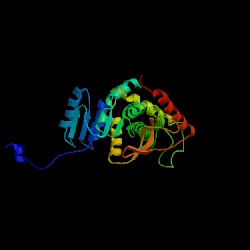
Pyruvate + NADH + H+ <----> Lactate + NAD+
Studies have shown that the reaction mechanism of LDH follows an ordered sequence. In order for lactate to be oxidized NAD+ must bind to the enzyme first followed by lactate. Transfer of a hydride ion then happens quickly in either direction giving a mixture of the two teranary complexes, enzyme-NAD+-lactate and enzyme-NADH-pyruvate. Finally pyruvate dissociates from the enzyme followed by NADH. The rate limiting step in this reaction is the rate of dissociation of NADH. The same holds true in the reverse reaction that the coenzyme, NADH, must bind first before the substrate, pyruvate, can bind. The conversion of pyruvate to lactate with the subsequent regeneration of NAD+ is a very favorable